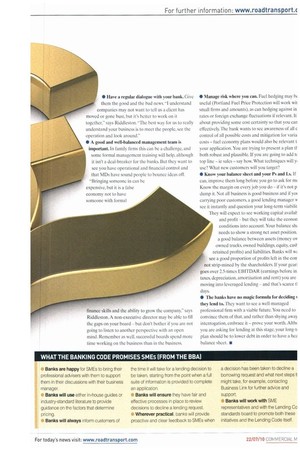A slice of
Page 40

Page 41

If you've noticed an error in this article please click here to report it so we can fix it.
thP action
With figures revealing E720bn has been lent to UK businesses, how much of this is filtering through to hauliers, and how can you ensure your firm is an attractive prospect for lenders? CM finds out.
Words: Louise Cote Following George Osborne's emergency Budget, the British Banking Association (BBA) said: "Currently, the high street banks are lending a total of t720bn to all UK businesses. A further .f:100bn is already committed to businesses of all types and is available to be used. We expect and are ready to increase lending over and above these amounts as the economy picks up." It says f54.5bn is being lent to smaller businesses, with £500m being approved each month.
So how do you ensure that you get your share of those impressive figures? Well, the banks are still careful about lending, even to established customers. and some are downright skittish about low-margin sectors, such as transport and construction.
Indeed, a number of names have pulled completely out of vehicle finance altogether.
With that in mind, what will make your company a more atiractive proposition to lenders?
• 'Ibe banks know that haulage companies have had it hard, struggling during the recession, but provided you have adapted sensibly to conditions, it should not in itself deter any bank from hacking you.This is not a
good time to change bank established customers are a better risk than new ones.
• Know what the money is for. is it for asset acquisition (trucks or trailers), term capital for buildings, or working capital? If your cashflow is poor, do everything you can to improve it before you sec the bank invoice factoring or putting someone in the office purely on credit management. Note that if some of your customers are good payers, invoice factoring may not be for you. You're handing a good chunk of your profit to someone else for no reason. Instead, talk to your other customers and if they don't pay in 45 days. pot a stop on the accounts.
• Once you have established a valid reason for needing the money, banks will want paper. Lots of it. Rob Riddleston, head of transport and logistics at Barclays Corporate, says: -We want a well thought out history strategy. current situation and business plan. That's hard to do in a recession, but try to he realistic and always have Plan Bs and contingencies laid down." Contingencies are crucial, he says, because there is always the 'volcano effect' the unforeseen complication from which you can't protect yourself. • Have a regular dialogue with your bank. Give them the good and the bad news. "I understand companies may not want to tell us a client has moved or gone bust, but it's better to work on it together,says Riddleston."The best way for us to really understand your business is to meet the people. see the operation and look around."
• A good and well-balanced management team is important. In family firms this can be a challenge, and some formal management training will help, although it isn't a deal-breaker for the banks. But they want to see you have operational and financial control and that MDs have sound people to bounce ideas off. "Bringing someone in can be expensive. but it is a false economy not to have someone with formal finance skills and the ability to grow the company." says Riddleston. A non-executive director may be able to fill the gaps on your board but don't bother if you are not going to listen to another perspective with an open mind. Remember as well, successful boards spend more time working on the business than in the business. • Manage risk where you can. Fuel hedging may bt useful (Portland Fuel Price Protection will work wit small firms and amounts). as can hedging against in rates or foreign exchange fluctuations if relevant. It about providing some cost certainty so that you can effectively. The bank wants to see awareness of all c control of all possible costs and mitigation for varia costs fuel economy plans would also be relevant t your application. You are trying to present a plan both robust and plausible. If you are going to add tt top line ie sales say how. What techniques will yl use? What new customers will you target?
• Know your balance sheet and your Ps and Ls. If can. improve them long before you go to ask for nat Know the margin on every job you do if it's not p dump it. Not all business is good business and if yoi carrying poor customers, a good lending manager v see it instantly and question your long-term viabilit They will expect to see working capital availah and profit but they will take the econon conditions into account. Your balance sh( needs to show a strong net asset position. a good balance between assets (money ov owned trucks, owned buildings, equity, cast retained profits) and liabilities. Banks will wi see a good proportion of profits left in the con not strip-mined by the shareholders. If your geari goes over 2.5-times EBITDAR (earnings before in taxes, depreciation, amortisation and rent) you are moving into leveraged lending and that's scarce tl days.
• The banks have no magic formula for deciding they lend to. They want to see a well-managed professional firm with a viable future. You need to convince them of that, and rather than shying away interrogation, embrace it prove your worth. Altht you are asking for lending at this stage, your long-ti plan should be to lower debt in order to have a he balance sheet. •
























































































































